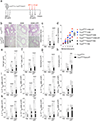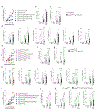A regulatory T cell Notch4-GDF15 axis licenses tissue inflammation in asthma
- PMID: 32929274
- PMCID: PMC7578174
- DOI: 10.1038/s41590-020-0777-3
A regulatory T cell Notch4-GDF15 axis licenses tissue inflammation in asthma
Erratum in
-
Author Correction: A regulatory T cell Notch4-GDF15 axis licenses tissue inflammation in asthma.Nat Immunol. 2021 Jan;22(1):100. doi: 10.1038/s41590-020-00841-w. Nat Immunol. 2021. PMID: 33214720 No abstract available.
-
Author Correction: A regulatory T cell Notch4-GDF15 axis licenses tissue inflammation in asthma.Nat Immunol. 2021 Jun;22(6):794-795. doi: 10.1038/s41590-021-00929-x. Nat Immunol. 2021. PMID: 33903767
Abstract
Elucidating the mechanisms that sustain asthmatic inflammation is critical for precision therapies. We found that interleukin-6- and STAT3 transcription factor-dependent upregulation of Notch4 receptor on lung tissue regulatory T (Treg) cells is necessary for allergens and particulate matter pollutants to promote airway inflammation. Notch4 subverted Treg cells into the type 2 and type 17 helper (TH2 and TH17) effector T cells by Wnt and Hippo pathway-dependent mechanisms. Wnt activation induced growth and differentiation factor 15 expression in Treg cells, which activated group 2 innate lymphoid cells to provide a feed-forward mechanism for aggravated inflammation. Notch4, Wnt and Hippo were upregulated in circulating Treg cells of individuals with asthma as a function of disease severity, in association with reduced Treg cell-mediated suppression. Our studies thus identify Notch4-mediated immune tolerance subversion as a fundamental mechanism that licenses tissue inflammation in asthma.
Figures
















Comment in
-
Wnt and Hippo pathways in regulatory T cells: a NOTCH above in asthma.Nat Immunol. 2020 Nov;21(11):1313-1314. doi: 10.1038/s41590-020-0797-z. Nat Immunol. 2020. PMID: 32968284 Free PMC article.
-
Notch4, uncovering an immunomodulator in allergic asthma.Allergy. 2021 Dec;76(12):3852-3854. doi: 10.1111/all.14968. Epub 2021 Jun 15. Allergy. 2021. PMID: 34050948 No abstract available.
References
-
- Lambrecht BN & Hammad H The immunology of asthma. Nat Immunol 16, 45–56 (2015). - PubMed
Publication types
MeSH terms
Substances
Grants and funding
LinkOut - more resources
Full Text Sources
Other Literature Sources
Medical
Molecular Biology Databases
Miscellaneous

